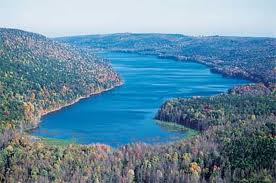Surface water, a term typically used to refer to non-saline water that is naturally exposed to the atmosphere, is the least abundant type of available freshwater. It makes up roughly 2% of the freshwater which is available for human use. Precipitation is the primary source of surface water. Common types of surface water include streams, water runoff, rivers, lakes, and ponds.
 Surface water is much more readily available for human use than other water sources such as ground water or glacial ice. This is due to the higher accessibility and abundance of surface water in many areas. This accessibility, however, does not make this form of freshwater the most optimal for human use. Surface water frequently has contaminants that require more robust and complete treatment than groundwater, which is often used without treatment.
Surface water is much more readily available for human use than other water sources such as ground water or glacial ice. This is due to the higher accessibility and abundance of surface water in many areas. This accessibility, however, does not make this form of freshwater the most optimal for human use. Surface water frequently has contaminants that require more robust and complete treatment than groundwater, which is often used without treatment.
Than other water sources such as ground water or glacial ice. This is due to the higher accessibility and abundance of surface water in many areas. This accessibility, however, does not make this form of freshwater the most optimal for human use. Surface water frequently has contaminants that require more robust and complete treatment than groundwater, which is often used without treatment.
In order to make use of surface water, issues of chemical and bacteriological contaminants must be handled. The properties of surface water are in constant flux. This creates a situation where it becomes difficult to treat surface water, whereas groundwater is comparatively stable.
The contaminants of surface water are primarily affected by human activity. Since a major source of recharge for surface water systems is through runoff, surface water may become contaminated by the pollutants associated with runoff. These pollutants include agricultural and industrial pollutants. An example is the process of heavy metal loading, which may occur as a direct result of dumping industrial waste. Heavy metals as well as toxic compounds, such as acids, further pollute the water. This often helps to suppress the biological processes which act to purify a river or stream.
Bacteriological concerns are, in large, associated with surface water storage. Both bacteria and parasites are provided with the nutrients to grow and populate in this environment. It is common for Municipal water systems to treat this problem through chlorination, coagulation, sedimentation and filtration of surface waters.
For the most part, groundwater and surface water are distinguished by location and time. A continuous process of exchange occurs between the two types of freshwater. For example, an effluent stream is one which receives water from groundwater. An influent stream is on that supplies water to groundwater. Groundwater moves at a much slower rate than surface water. This can cause contamination which may emerge from groundwater years after the injection. Thus, another source of contamination is groundwater discharge to lakes or streams.






